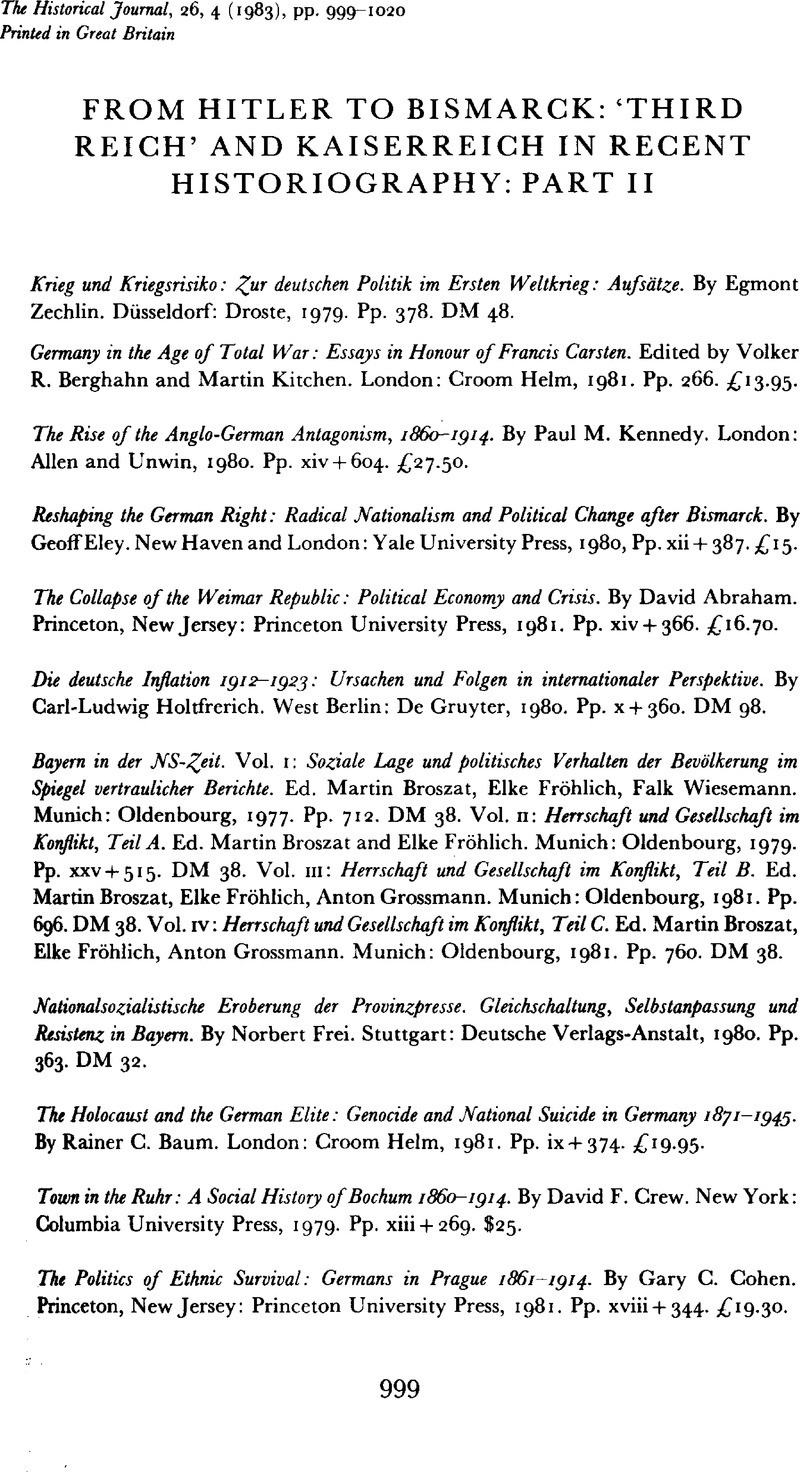Article contents
From Hitler to Bismarck: ‘Third Reich’ and Kaiserreich in Recent Historiography: Part II
Published online by Cambridge University Press: 11 February 2009
Abstract

- Type
- Review Articles
- Information
- Copyright
- Copyright © Cambridge University Press 1983
References
1 Historical Journal, xxvi (1983), no. 2, 485–97.Google Scholar
2 Röhl, J. C. G. and Sombart, Nicolaus (eds.), Kaiser Wilhelm II: new interpretations (Cambridge, 1982), discussed in Part I of this review article.Google Scholar
3 Summarized in several of the contributions to Hirschfield, G. and Kettenacker, L. (eds.), The ‘Führer state’: myth and reality: studies on the structure and politics of the Third Reich (Stuttgart, 1981), discussed in Part I of this review article.Google Scholar
4 Mommsen, Wolfgang J., ‘Domestic factors in German foreign policy before 1914’, Central European History, vi (1973), no. 1, 3–43.CrossRefGoogle Scholar
5 Cf. Kennedy, Paul M., The Samoan tangle: a study in Anglo-German-American relations 1878–1890 (Dublin, 1974).Google Scholar
6 See Part I above, pp. 491–3.
7 See the discussion in Part I above, pp. 491–3.
8 Studies along these lines include a number of the essays collected in Evans, Richard J. (ed.), Society and politics in Wilhelmine Germany (London, 1978)Google Scholar, and especially David, Blackbourn, Class, religion and local politics in Wilhelmine Germany: the Centre party in Würtemberg before 1914 (London, 1980).Google Scholar
9 Cf. Eley's earlier articles on these themes, especially ‘Defining social imperialism: use and abuse of an idea’, Social History, I, no. 3 (1976), 265–90Google Scholar; ‘Sammlungspolitik, Social Imperialism and the Navy Law of 1898’, Militärgeschichtliche Mitteilungen, I (1974), 29–63Google Scholar; ‘Capitalism and the Wilhelmine state’, The Historical Journal, xxi no. 3 (1978), 737–50, and his contribution to Society and politics in Wilhelmine Germany (note 8, above).Google Scholar
10 See especially the attacks on David, Blackbourn and Geoff, Eley, Mythen deutscher Geschichtsschreibung: die gescheiterte bürgerliche Revolution von 1848 (Frankfurt, 1980), by Hans-Jürgen Puhle in Journal für Geschichte (1981), Heft 4, 44–5 and Hans-Ulrich Wehler in Merkur (1981), Heft 5, 478–87, with replies in following issue, pp. 757–60. These articles take up some of the points made in Eley's monograph.Google Scholar
11 Wilhelm, Deist, Flottenpolitik und Flottenpropaganda: das Nachrichtenbureau des Reichsmarineamts, 1897–1914 (Stuttgart, 1976).Google Scholar
12 Bernd, Weisbrod, Schwerindustrie in der Weimarer Republik: Interessenpolitik zwischen Stabilis-ierung und Krise (Wuppertal, 1978)Google Scholar; Reinhard, Neebe, Grossindustrie, Staat und NSDAP I930–1933: Paul Silverberg und der Reichversband der Deutschen Industrie in der Krise der Weimarer Republik (Göttingen, 1981)Google Scholar; Michael, Grübler, Die Spitzenverbände der Wirtschafl und das erste Kabinett Brüning: Vom Ende der Grossen Koalition 1929/30 bis zum Vorabend der Banken 1931: Eine Quellenstudie (Düsseldorf, 1982), are three recent empirical studies.Google Scholar
13 Ursula, Büttner, Hamburg in der Staats- und Wirtschaftskrise 1928–31 (Hamburg, 1982).Google Scholar
14 Klaus, Tenfelde, Sozialgeschichte der Bergarbeiterschaft an der Ruhr im 19. Jahrhundert (Bonn, 1977).Google Scholar
15 Work carried out as part of this general project is available in English in Ian Kershaw, Popular opinion and political dissent in the Third Reich: Bavaria 1933–1945 (Oxford, 1981)Google Scholar. A parallel project on the nineteenth century, also supervised by Broszat and similarly rich in fresh insights and perspectives is Gert, Zang (ed)., Provinzialisierung einer Region: Regionale Unterentwicklung und liberale Politik in der Stadt and im Kreis Konstanz im 19. Jahrhundert. Untersuchungen zur Entstehung der Bürgerlichen Gesellschaft in der Provinz(Frankfurt, 1978).Google Scholar
16 Erhard, Lucas, Zwei Formen von Radikalismus in der deutschen Arbeiterbewegung (Frankfurt, 1976).Google Scholar
17 Ralf, Dahrendorf, Society and democracy in Germany (London, 1968).Google Scholar
18 See for example Kriedte, P., Medick, H., Schlumbohm, J., Industrialization before industrialization: rural industry in the genesis of capitalism (Cambridge, 1981); or the various contributions to the series ‘ Sozialgeschichtliche Bibliothek’ edited by Dieter Groh and published by the Ullstein Verlag.Google Scholar
19 Michael, Kater, ‘Hitler in a social context’, Central European History, xiv, 3 (1981), 243–72.Google Scholar
20 Ian, Kershaw, Der Hitler-Mythos: Volksmeinung und Propaganda im Dritten Reich (Stuttgart, 1980).Google Scholar
21 G. Hirschfeld, L. Kettenacker (eds.), The ‘Führer state’, p. 37.
22 See Rudy, Koshar, ‘Away from the centre: two recent local studies of Nazism from the Federal Republic’, Social History, viii, I (January 1983), 77–86.Google Scholar
- 1
- Cited by


